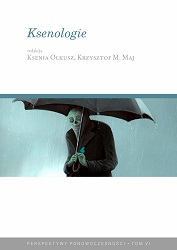Na rubieżach społeczeństwa. Wizerunki paryskich imigrantów we współczesnym kinie francuskim
On the Boundary of Society. Images of Parisian Immigrants in Contemporary French Cinema
Author(s): Marta Kasprzak
Subject(s): Philosophy, Fine Arts / Performing Arts, Film / Cinema / Cinematography
Published by: Ośrodek Badawczy Facta Ficta
Keywords: socio-cultural landscape of Paris;French cinema;contemporary French cinema; immigrants in film;film portraits of immigrants;beur cinema;suburban cinema
Summary/Abstract: The urban landscape of Paris has been an important element of the diegetic space constructed by filmmakers for almost a century. Already in the 1920s, René Clair and Alberto Cavalcanti placed locale of their films—representing the genre of urban symphonies—in the capital of France, making the urban space not only the background of screen episodes, but their full-fledged protagonist. Over the following decades, Paris has marked the boundaries of the world populated by the variety of characters, among which the category of immigrants deserves particular attention. Complex relations between foreigners and natives or state authorities have become the subject of numerous films belonging to beur cinema and cinéma de banlieue. The issue of assimilation, characteristic for foreign visitors, is shown on the example of the following films: La haine by Mathieu Kassovitz, Dheepan by Jacques Audiard, and Peur de rien by Danielle Arbid. In the chapter On the boundary of society. Images of Parisian immigrants in contemporary French cinema Marta Kasprzak proposes to treat the motif of the city's presence in films as a focal point for socio-cultural reflection that encapsulates the phenomenon of atrophy of social bonds, apparent cultural assimilation, and acts of violation of the applicable law or social orderThe urban landscape of Paris has been an important element of the diegetic space constructed by filmmakers for almost a century. Already in the 1920s, René Clair and Alberto Cavalcanti placed locale of their films—representing the genre of urban symphonies—in the capital of France, making the urban space not only the background of screen episodes, but their full-fledged protagonist. Over the following decades, Paris has marked the boundaries of the world populated by the variety of characters, among which the category of immigrants deserves particular attention. Complex relations between foreigners and natives or state authorities have become the subject of numerous films belonging to beur cinema and cinéma de banlieue. The issue of assimilation, characteristic for foreign visitors, is shown on the example of the following films: “La haine” by Mathieu Kassovitz, “Dheepan” by Jacques Audiard, and “Peur de rien” by Danielle Arbid. In the chapter “On the Boundary of Society. Images of Parisian Immigrants in Contemporary French Cinema” Marta Kasprzak proposes to treat the motif of the city's presence in films as a focal point for socio-cultural reflection that encapsulates the phenomenon of atrophy of social bonds, apparent cultural assimilation, and acts of violation of the applicable law or social order
Book: Ksenologie
- Page Range: 431-448
- Page Count: 18
- Publication Year: 2018
- Language: Polish
- Content File-PDF

